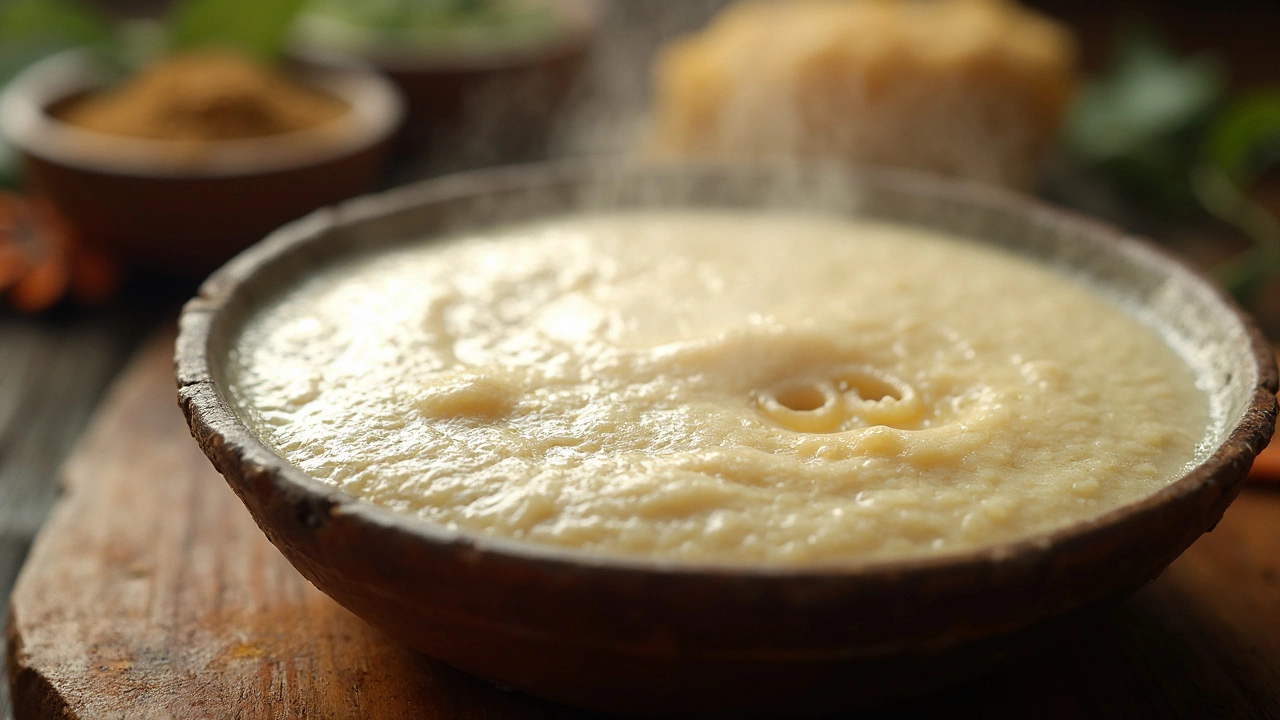10 Secrets to Speed Up Dosa Batter Fermentation Naturally
 Feb, 16 2025
Feb, 16 2025
Ever found yourself waiting impatiently for dosa batter to ferment, only to be disappointed by its sluggish pace? Trust me, you're not alone. Getting that perfect batter consistency without artificial shortcuts can feel like hitting a jackpot. But worry not, I've got some tricks up my sleeve for you.
Fermentation is a magical process that combines art and science, and it doesn’t have to take forever. Using natural methods, you can encourage the bacteria to do their job faster. It's all about the right environment and a bit of patience. Let's get into the nitty-gritty so you can enjoy those crispy, golden dosas sooner rather than later.
- Understanding Fermentation
- Choosing the Right Ingredients
- Temperature Tricks
- How to Store for Best Results
Understanding Fermentation
So, what’s the deal with fermentation in dosa batter? It's all about good bacteria doing their happy dance in your mix. This process not only breaks down the starches in rice and urad dal but also enhances the flavor and nutritional profile of the dosas. A well-fermented batter will give you that fluffy, delicious outcome.
The secret weapon here is a group of microorganisms, primarily lactic acid bacteria and yeast. These guys work together to convert sugars into lactic acid, carbon dioxide, and a host of other components that make your dosa soft inside and crispy outside. But don’t worry, it's all happening at a microscopic level.
The Science Behind It
Fermentation for cooking tips starts when you mix your ground rice and urad dal with water. The natural microorganisms on these seeds begin feeding on the sugars, which creates gases that help your batter rise. It's fascinating how just the right conditions can make these tiny helpers thrive.
Temperature plays a huge part. Most microorganisms prefer a warm environment—think around 86°F (30°C). Any colder, and everything slows down; a warmer spot can speed things up but be careful not to overdo it.
Signs of Perfect Fermentation
So, how do you know when your batter is ready? Look for bubbles on the surface, a slight increase in volume, and a tangy aroma. If it smells sour like a mild yogurt, you're good to go. And taste—don’t be shy to give it a small taste test.
| Factor | Optimal Condition |
|---|---|
| Temperature | 86°F (30°C) |
| Time | 8-12 Hours |
Now that you've got the basics down, you'll be equipped to tweak and control the fermentation process as you like. The more you experiment, the better you'll get, and soon, your Indian cuisine game will be on point. Remember, it's all in the details.
Choosing the Right Ingredients
Here’s a little secret: the magic of a perfect dosa batter starts with picking the right stuff. You might think it's all about technique, but it actually boils down to what goes in.
Rice and Dal Blend
You can't have a decent dosa without a balanced mix of rice and black gram (urad dal). Traditionally, the ratio is about 3:1, but don't get stuck on the numbers. Feel free to tweak it to suit your taste; some folks go for a 4:1 ratio for extra crispiness.
Using parboiled rice instead of plain white rice can also work wonders. It's got a higher starch content which naturally enhances fermentation.
The Power of Fenugreek Seeds
A pinch of fenugreek seeds can help ferment the fermentation process. Why? Because these little guys are packed with natural enzymes and nutrients that boost bacterial growth. So don't skip them!
Fresh, Quality Ingredients
Seems obvious, but it’s often overlooked. If that rice or dal has been sitting in your pantry for too long, it won't ferment as well as fresh produce. So pick up some fresh quality grains from your local store.
Optional Add-ins
Here’s where you can get a bit adventurous. Adding a handful of poha (flattened rice) or a small boiled potato to your batter can make your dosas softer inside. Both of these ingredients help with moisture retention, giving you that perfect texture.
Remember, it's not just about following a recipe. It's about understanding each ingredient's role in making that perfect batch of dosa. Once you get the hang of it, you're on the fast track to dosa heaven.

Temperature Tricks
Temperature plays a huge role in how quickly your dosa batter ferments. If you're in a rush or live in a cooler place, you might need to give your batter a little more warmth to get things moving.
Optimal Room Temperature
The sweet spot for fermenting dosa batter is around 25-32°C (77-89.6°F). This range is like a tropical paradise for the bacteria, letting them thrive and work their magic. So, if you live somewhere cold, consider these simple tricks:
- Use an Oven Light: Pop the batter bowl in the oven with just the light on. It provides just enough heat to speed up fermentation without cooking the batter.
- Warm Spots in the House: Check for the warmest spot, like near a heater or even on top of the fridge.
Utilize Warm Water
When initially mixing your ingredients, use warm water instead of cold. This can give the fermentation process a head start, especially on chilly days.
Insulate Your Container
Keep your batter cozy! Wrap the container with a kitchen towel or place it in a microwave oven (switched off) to help it stay warm. Insulation is key when the room is colder than you'd like.
Statistical Temperature Hacks
Here's something interesting. A study in South Indian households found that fermentation times were reduced by up to 50% when a consistent temperature close to 32°C was maintained. That's a win-win, right?
By getting creative with how you manage temperature, the fermentation process becomes less of a waiting game and more of a certainty. Try out these tricks and see which works best for your kitchen. You'll never look at the thermometer the same way again!
How to Store for Best Results
Storing your dosa batter properly can dramatically influence its success in fermentation. It’s not just about keeping it in the fridge; understanding how and where to store it can make all the difference.
Use a Proper Container
First things first, always choose a container that's slightly larger than the amount of batter you have. This allows room for the batter to rise during fermentation. A glass or BPA-free plastic container with a lid is often your best bet. Avoid metal containers, as they can react with the batter.
Temperature Matters
If you’re storing the batter for the next day's breakfast, it's generally best to leave it in a warm spot overnight to really get the fermentation going strong. For longer storage, keep it in the fridge to slow down the fermentation, which helps maintain the right flavor and texture.
Portion Control
If you're whipping up enough batter for a couple of days or more, consider portioning it out into smaller containers before storage. This way, you only take out what you need, keeping the rest undisturbed and maintaining its cooking quality for future use.
Cover Smartly
When covering the container, make sure there's enough room for air to escape, especially during the fermentation phase. A loose-fitting lid or even a clean cloth secured with a rubber band can do the trick.
Longevity of Stored Batter
Wondering how long you can keep that batter in the fridge? Stored correctly, you can keep it up to five days without any major drop in quality. Check out this quick guide to help you:
| Storage Location | Duration |
|---|---|
| Room Temperature | 8-12 Hours |
| Refrigerator | Up to 5 Days |
By following these storage tips, you’ll keep your dosa batter fresh and ready for whenever that dosa craving hits you. Happy fermenting and enjoy those crispy delights!